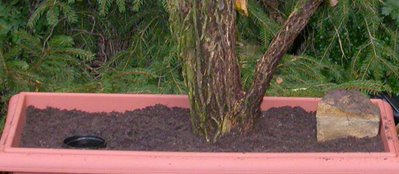First anniversary of project


Today is the first anniversary of the project and the pictures above show how the window box was in November 2005 compared with how it is now. On my visit I noticed on the shady side of the sallow log two small resupinate fungi, a greyish white one and a pink one. These are the first fungi recorded. I also caught a short-palped cranefly, Erioptera griseipennis, resting on the bark.
Many of the naturally occurring Wbx plants of the last twelve months have clearly sown themselves from parents growing in the garden and the early appearance of species like buddleia, Leycesteria, alexanders, grey sallow, birch and tutsan demonstrates how easily these establish themselves in ‘waste ground’.
Some plants would have tended to take over if I had not controlled them. The white clover would have spread over the whole soil surface, for example, and I have had to remove the stinging nettle and several buddleias and grey sallows.
The groundsel, Senecio vulgaris, was an interesting plant. It appeared early on and grew, flowered and seeded well. Several new plants then developed from the seeds but, after attack by aphids and probably flea beetles, they went into a decline and now appear to be extinct in Wbx. A few seedlings of other species vanished before they had had a chance to get beyond the cotyledon stage and some slightly larger plants I could not identify died young.
During the very hot weather in summer the first birch seedling looked as though it was going to die, but it recovered and still carries some leaves. Elsewhere other birch seedlings have appeared.
The following species have been confirmed as occurring (nothing, of course, has been deliberately introduced):
A birch, Betula sp.
Butterfly-bush, Buddleja davidii
A crane’s-bill, Geranium sp.
Herb-robert, Geranium robertianum
Greater plantain, Plantago major
Procumbent pearlwort, Sagina procumbens
Grey willow, Salix cinerea
Groundsel, Senecio vulgaris
Stinging nettle, Urtica dioica
Tent spider, Pisaura mirabilis
A woodlouse, Porcellionides cingendus
A woodlouse, Trichoniscus pusillus
A reticulated slug, Deroceras reticulatum
A springtail, Entomobrya nivalis
A bark louse, Ectopsocus briggsi
A leaf hopper, Empoasca vitis
An aphid (on groundsel)
A flea beetle, Longitarsus flavicornis
Shining sweep moth, Psyche casta
Mosquitoes (larvae in small pool)
A moth fly, Psychoda sp.
A winter gnat, Trichocera sp.
A short-palped cranefly, probably Limonia chorea
A short-palped cranefly, Erioptera griseipennis
A non-biting midge, Bryophaenocladius xanthogyne
A non-biting midge, Gymnometriocnemus brumalis
A dance fly, Rhamphomyia longipes
A dolichopodid fly, Dolichopus griseipennis
A dolichopodid fly, Chrysotus sp.
A dolichopodid fly, Medetera truncorum
Marmalade fly, Episyrphus balteatus
A greenbottle, Eudasyphora cyanella
A flesh fly, Sarcophaga sp.
Chalcid wasps, Chalcididae (several)
European Robin, Erithacus rubecula
Common Blackbird, Turdus merula
These are those that are awaiting confirmation of identity:
A grass (one plant only)
An exotic maple, Acer sp.
A rush, Juncus sp.
A willow herb, Epilobium sp.
Alexanders, Smyrnium olusatrum
Dandelions, Taraxacum sp.
Deptford pink, Dianthus armeria
Himalayan honeysuckle, Leycesteria formosa
Tutsan, Hypericum androsaemum
Several vascular plants not even determinable to family level.
Wall screw-moss, Tortula muralis
Five or six other mosses
Two fungi
I estimate that I have seen around 60 species over this first year and there will, of course, be plenty of unseens: the creatures that settle for a while by day or night, the fauna and flora in the soil or the pond, the microscopic organisms.


